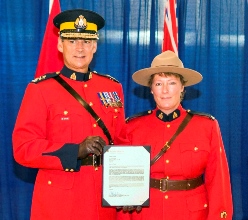They call it the Sunshine Coast — a 140 kilometre stretch of land alongside Highway 101 that was policed by a total of 10 officers in 2015, seven of which were women.
An analysis of data collected by Statistics Canada shows that in 2015, the Sunshine Coast RCMP detachment, located in the District of Sechelt, British Columbia, had the highest percentage of female police officers in the country.
Tucked between the Sechelt Inlet and Strait of Georgia, its policing area spans the size of 400,000 football fields, including 12 townships, a Shíshálh First Nation Community and a section of Squamish Nation.
The Sunshine Coast offers a Restorative Justice Program based on Indigenous teachings, which is not uncommon among B.C. based RCMP detachments as listed on the RCMP website.
Given the eclectic terrain of rock, forest, and sea, the Sunshine Coast officers often patrol the surrounding area on mountain bikes and ATV’s. In the past, the officers on such patrols have saved both a bald eagle and an owl, according to the unit’s Twitter feed.

Officers like Constable Karen Whitby who, in addition to rescuing an injured, unconscious owl in November 2016, was honoured with a Commanding Officer’s Letter of Appreciation last fall. Cst Whitby had been dispatched to look into the supposed disappearance of a 56-year-old man. It was trusting her intuition and following a “terrible feeling” in the pit of her stomach that led Cst Whitby directly to the missing man just in time to save his life.
Cst Whitby was one of seven women at the Sunshine Coast in 2015, which is the detachment’s highest number of female officers on record.
Despite being a historically male profession, as noted by the data, a nationwide increase in female officers has manifested in the police resources data presented by Statistics Canada in the last fifteen years. In 2015, women police officers accounted for 20 per cent of all the officers in Canada.
About an hour southeast of Sechelt, the North Vancouver City RCMP detachment reported a significantly smaller percentage, with only one in three officers being female. A lower percentage than the Sunshine Coast yet much larger when compared with the number of female officers in the five largest police forces in the country.
Times have changed considerably according to Superintendent Chris Kennedy of the North Vancouver City detachment, who says he can recall when a given force had its “two token females.” Superintendent Kennedy has been serving as an officer for almost four decades.
“I don’t care what sex you are, as long as you can lead,” he says, which is something a lot of female officers are starting to do.
In conjunction with the growth seen in the number females in policing nationwide, there has been an increase in the number of women holding senior positions in the force. However, the definition of “senior officer” can differ from province to province and whether it is a RCMP detachment or a municipal department. For example, the highest ranking officer in Ottawa is the chief of police, while the highest ranking officer in the RCMP is the commissioner.
Even though the number of female officers in the police force has increased, Statistics Canada reported that there was a minute decrease in the total number of officers across the country. Every province and territory, with the exception of Alberta and Newfoundland and Labrador, saw a drop in the volume of police from 2014 to 2015.
Statistics Canada has not yet released any information regarding police resources in Canada for 2016.

